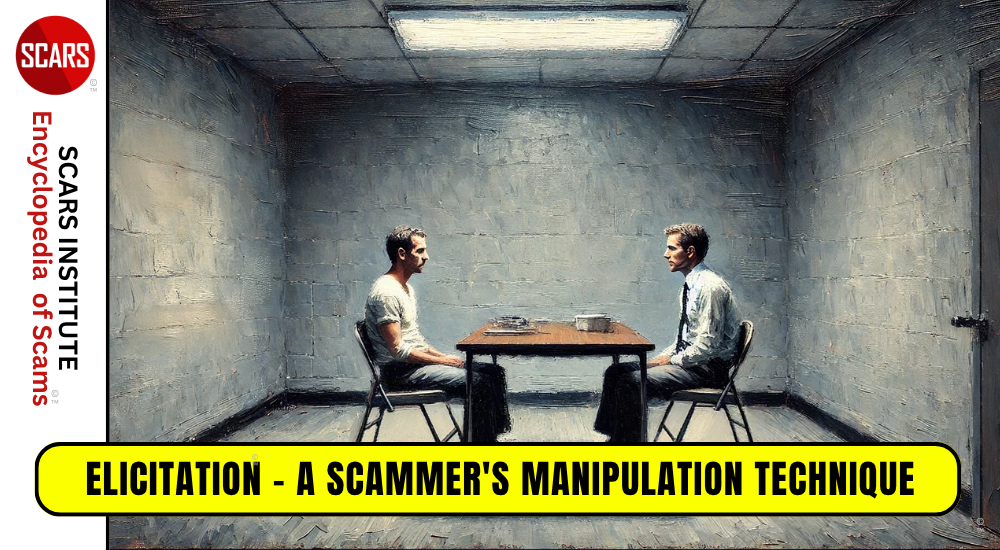ANTI-SCAM TIP: Fake Videos and Information are Almost Indistinguishable Now
How to Spot and Question Suspicious or Fake Videos and Information in a World Where Fake and Real Blur Together Indistinguishably
A SCARS Institute Anti-Scam Tip
Author:
• SCARS Institute Encyclopedia of Scams Editorial Team – Society of Citizens Against Relationship Scams Inc.
Article Abstract
In an era where real and fake content blur together, distinguishing between manipulated and authentic videos has become increasingly challenging. Deepfake technology and social engineering tactics exploit emotions like fear, anger, or excitement to drive impulsive reactions before critical thinking can take place. To guard against misinformation, it’s essential to pause and analyze emotional responses before reacting.
Investigating the video’s original source, conducting reverse image searches, and verifying claims through reputable news outlets can help uncover manipulation.
Looking at comments for fact-checking links, identifying mismatched emotions in deepfakes, and questioning who benefits from the video’s message are key steps in recognizing deception.
Skepticism is the best defense—by defaulting to doubt and delaying engagement until verification is complete, individuals can help prevent the spread of misinformation and protect themselves from being manipulated.

Anti-Scam Tip: How to Spot and Question Suspicious or Fake Videos and Information in a World Where Fake and Real Blur Together Indistinguishably
We are living in an era where distinguishing between real and fake videos and other information has become incredibly difficult.
Thanks to advanced technology, artificial intelligence, and deepfake tools, manipulated content is more convincing than ever. Unlike a suspicious email or an unfamiliar phone call, verifying the authenticity of a video isn’t as straightforward as checking the sender or making a phone call. So what do you do when a video pops up unexpectedly on your feed, triggering an emotional reaction? The key is to pause and question before reacting.
Stop and Analyze Your Reaction
One of the most common ways manipulated content spreads is by triggering strong emotions—anger, fear, outrage, or even excitement. Scammers, propagandists, and malicious actors rely on quick emotional reactions to bypass rational thinking. If you feel an overwhelming urge to share or respond immediately, take a step back. That emotional jolt is your cue to slow down.
You may never be 100% certain if a video is fake, but stopping to think critically already puts you ahead of those who are easily manipulated.
Track Down the Original Source
One of the best ways to verify a questionable video is to track down where it originally came from. Videos that go viral on social media are often shared out of context, edited, or intentionally misrepresented. Start by searching for the video on reputable news sites or fact-checking platforms.
Here are a few steps to help you investigate:
- Reverse Image Search – Take a screenshot of the video and run it through a reverse image search tool like Google Lens or TinEye. This might lead you to the original source or a fact-checking article.
- Check for Watermarks or Logos – Many misleading videos steal footage from legitimate sources but blur out logos or crop the video to remove identifying marks. If a news station’s watermark is missing, that’s a clue that the video may have been altered.
- Look at the Metadata – If you have access to the original file, metadata can reveal when and where the video was recorded. Some online tools and news agencies analyze metadata to expose manipulated content.
- Compare to Official Sources – If the video claims to show breaking news, check if reputable news agencies are covering it. If no major outlets are reporting the same event, it might be fabricated or taken out of context.
Examine the Comments for Clues
Before believing a viral video, take a look at the comments section. Many times, people with expertise or prior knowledge may have already pointed out inconsistencies, debunked the footage, or linked to fact-checking sources. Social media platforms, while prone to misinformation, also have users dedicated to exposing fake content.
Look for:
- Fact-checking links – Some users may share sources debunking the video.
- Doubts from credible users – If people who specialize in media, technology, or journalism are questioning it, take their skepticism seriously.
- Patterns of bots or coordinated promotion – If the comments are overwhelmingly one-sided and push a particular narrative aggressively, it could be part of an organized disinformation campaign.
Watch for Mismatched Emotions and Body Language
Deepfake technology is improving, but it still struggles with syncing voice, facial expressions, and body language. If someone in a video appears to be delivering serious or emotional news, but their expressions and gestures don’t match, be suspicious.
Red flags include:
- Emotionless expressions – If someone is supposedly sharing devastating or urgent news but their face remains neutral, it may be a sign of digital manipulation.
- Inconsistent hand gestures – People naturally use their hands while speaking. If a person’s hands remain unnaturally stiff or out of sync with their speech, it could be a sign of artificial generation.
- Unnatural blinking or eye movement – Many deepfake videos struggle to replicate realistic eye movement. If someone barely blinks, stares unnaturally, or their gaze seems “off,” this could indicate AI-generated manipulation.
Default to Skepticism
In today’s digital landscape, the safest approach is to start by not trusting the video at all. Until you can confirm the source and authenticity, assume that it could be manipulated or misleading. The more people who practice critical thinking and skepticism, the less effective misinformation campaigns become.
By slowing down, questioning sources, analyzing body language, and checking for inconsistencies, you can protect yourself from falling for deceptive content. In a world where technology is making fake appear real, skepticism is your strongest defense.
A Step-by-Step Guide to Protect Yourself from Social Engineering
Manipulated content—whether deepfake videos, edited news clips, or misleading narratives—spreads because it triggers strong emotions. Social engineers, scammers, and propagandists rely on emotional manipulation to override rational thinking. The more urgent or emotionally charged a piece of content appears, the more likely people are to react impulsively without questioning its authenticity.
If you find yourself feeling an intense emotional reaction—whether it’s outrage, fear, sadness, or excitement—this is your first warning sign. That emotional jolt is your cue to stop and critically assess what you are seeing before reacting or sharing it further.
Step 1: Identify the Emotion Being Triggered
Pause for a moment and ask yourself:
-
-
- What am I feeling right now? (anger, fear, excitement, sympathy, etc.)
- How strong is my urge to act on this feeling?
- Would I normally react this strongly to a similar event?
-
Manipulative content is designed to create urgency and prevent logical processing. If you feel a powerful need to react immediately—by sharing, commenting, donating, or engaging—that’s a red flag. Your emotions may be clouding your judgment, making you more vulnerable to misinformation.
Step 2: Question the Timing
Ask yourself:
-
-
- Why am I seeing this video now?
- Does this align with a current event or controversy?
- Is the timing meant to provoke a particular reaction from viewers?
-
Social engineers carefully plan when and how to release content for maximum impact. If a video appears during a time of heightened tensions—elections, crises, or political conflicts—it could be designed to manipulate public opinion. Scammers also use this tactic, releasing fake fundraising campaigns immediately after disasters when emotions are running high.
Step 3: Consider Who Benefits from Your Reaction
Think about:
-
-
- Who gains something if I believe and share this video?
- Is there a political, financial, or ideological motive behind it?
- Does the source of the video have a history of spreading misinformation?
-
If a video is trying to convince you of something, consider the motive. Is it trying to sell you a product, persuade you of a political stance, or make you distrust a certain group? Propaganda and scams work by appealing to emotions and making people act before they think.
Step 4: Look for Authority and Verification
Before assuming a video is real, ask yourself:
-
-
- Has this event been reported by reputable news sources?
- Are fact-checking organizations discussing this claim?
- Can I find original footage from a reliable source?
-
A common social engineering trick is using low-quality or cropped video to remove identifying information. Scammers and propagandists rely on people assuming that just because something looks real, it must be real. Before reacting, search for the same event from verified news outlets. If a major event isn’t being covered by multiple sources, be skeptical.
Step 5: Reverse the Perspective
Try flipping the situation and looking at it from another angle:
-
-
- If I saw this same video but from the opposite perspective, would I still believe it?
- Am I more likely to believe this because it aligns with my personal opinions?
- Would I be this emotionally invested if this video was about a different person or group?
-
Social engineers know that people are more likely to believe things that confirm their existing biases. If the video supports your pre-existing beliefs, be extra cautious—it may be playing on confirmation bias to get you to react.
Step 6: Look for Inconsistencies in the Content
Finally, before reacting, scrutinize the video itself:
-
-
- Does the audio match the lips and body language of the person speaking?
- Is the lighting or background inconsistent in a way that suggests manipulation?
- Are there unnatural facial movements, blinking, or gestures that seem off?
-
Deepfake videos and edited footage often have small errors that can reveal their artificial nature. Pay close attention to the details—if something seems “off,” trust your instincts and verify before engaging.
Final Thought: When in Doubt, Do Nothing
If you’re not sure whether a video is real or fake, the best action is no action. Don’t share, don’t comment, and don’t engage until you have confirmed its authenticity. By practicing skepticism and questioning content before reacting, you reduce the spread of misinformation and protect yourself from emotional manipulation.
In today’s digital landscape, critical thinking is one of the best defenses against deception. Always take a moment to stop, analyze, and verify before allowing a video to dictate your emotions or actions.
-/ 30 /-
What do you think about this?
Please share your thoughts in a comment below!
Article Rating
Table of Contents
- How to Spot and Question Suspicious or Fake Videos and Information in a World Where Fake and Real Blur Together Indistinguishably
- Article Abstract
- Anti-Scam Tip: How to Spot and Question Suspicious or Fake Videos and Information in a World Where Fake and Real Blur Together Indistinguishably
- Stop and Analyze Your Reaction
- Track Down the Original Source
- Examine the Comments for Clues
- Watch for Mismatched Emotions and Body Language
- Default to Skepticism
- A Step-by-Step Guide to Protect Yourself from Social Engineering
- Final Thought: When in Doubt, Do Nothing
RATE THIS ARTICLE?
LEAVE A COMMENT?
Recent Comments
On Other Articles
- Nikolaus on Dating Scammers Paradise: Ivory Coast: “The Ivory Coast romance scam is still going on. It seems that local authorities don’t handle the issue effectively!” Dec 10, 02:17
- on The SCARS Institute Top 50 Celebrity Impersonation Scams – 2025: “Thank you – we will.” Dec 7, 11:41
- on The SCARS Institute Top 50 Celebrity Impersonation Scams – 2025: “You should add Sean Bean to your list of Celebrities. This one is very good, and persistent. He will be…” Dec 2, 12:07
- on How You Think & Talk About Your Scam Affects Your Recovery: “I have hung on to the scams for far too long. With the intervention of an all-merciful God, I have…” Nov 6, 22:13
- on Disengaging From A Fake Scam Relationship: “Taci, you may want to join our new support community at www.SCARScommunity.org” Nov 6, 03:01
- on Disengaging From A Fake Scam Relationship: “This particular article helped me discover the many things I did wrong the first time I was scammed. I should…” Nov 5, 22:49
- on About the SCARS RomanceScamsNOW.com Website – 24 Years Published: “It was unavailable for a few days, but it is available again. If he would be interested, he is welcome…” Nov 5, 00:59
- on About the SCARS RomanceScamsNOW.com Website – 24 Years Published: “My husband has been scammed and your classes have been helping him but now he can’t seem to access them.…” Oct 26, 14:57
- on Talia Shepard – Impersonation Victim – Stolen Photos – 2024: “Hi, I’m Patrick from Belgium and I found this site by chance, so I just got to know it, and…” Oct 17, 23:46
- on Talia Shepard – Impersonation Victim – Stolen Photos – 2024: “Hallo ik ben Patrick uit Belgie en het is in verband over PayPal. Ik heb het dit jaar spijtig genoeg…” Oct 17, 23:08
ARTICLE META
Important Information for New Scam Victims
- Please visit www.ScamVictimsSupport.org – a SCARS Website for New Scam Victims & Sextortion Victims
- Enroll in FREE SCARS Scam Survivor’s School now at www.SCARSeducation.org
- Please visit www.ScamPsychology.org – to more fully understand the psychological concepts involved in scams and scam victim recovery
If you are looking for local trauma counselors please visit counseling.AgainstScams.org or join SCARS for our counseling/therapy benefit: membership.AgainstScams.org
If you need to speak with someone now, you can dial 988 or find phone numbers for crisis hotlines all around the world here: www.opencounseling.com/suicide-hotlines
A Note About Labeling!
We often use the term ‘scam victim’ in our articles, but this is a convenience to help those searching for information in search engines like Google. It is just a convenience and has no deeper meaning. If you have come through such an experience, YOU are a Survivor! It was not your fault. You are not alone! Axios!
A Question of Trust
At the SCARS Institute, we invite you to do your own research on the topics we speak about and publish, Our team investigates the subject being discussed, especially when it comes to understanding the scam victims-survivors experience. You can do Google searches but in many cases, you will have to wade through scientific papers and studies. However, remember that biases and perspectives matter and influence the outcome. Regardless, we encourage you to explore these topics as thoroughly as you can for your own awareness.
Statement About Victim Blaming
Some of our articles discuss various aspects of victims. This is both about better understanding victims (the science of victimology) and their behaviors and psychology. This helps us to educate victims/survivors about why these crimes happened and to not blame themselves, better develop recovery programs, and to help victims avoid scams in the future. At times this may sound like blaming the victim, but it does not blame scam victims, we are simply explaining the hows and whys of the experience victims have.
These articles, about the Psychology of Scams or Victim Psychology – meaning that all humans have psychological or cognitive characteristics in common that can either be exploited or work against us – help us all to understand the unique challenges victims face before, during, and after scams, fraud, or cybercrimes. These sometimes talk about some of the vulnerabilities the scammers exploit. Victims rarely have control of them or are even aware of them, until something like a scam happens and then they can learn how their mind works and how to overcome these mechanisms.
Articles like these help victims and others understand these processes and how to help prevent them from being exploited again or to help them recover more easily by understanding their post-scam behaviors. Learn more about the Psychology of Scams at www.ScamPsychology.org
Psychology Disclaimer:
All articles about psychology and the human brain on this website are for information & education only
The information provided in this article is intended for educational and self-help purposes only and should not be construed as a substitute for professional therapy or counseling.
While any self-help techniques outlined herein may be beneficial for scam victims seeking to recover from their experience and move towards recovery, it is important to consult with a qualified mental health professional before initiating any course of action. Each individual’s experience and needs are unique, and what works for one person may not be suitable for another.
Additionally, any approach may not be appropriate for individuals with certain pre-existing mental health conditions or trauma histories. It is advisable to seek guidance from a licensed therapist or counselor who can provide personalized support, guidance, and treatment tailored to your specific needs.
If you are experiencing significant distress or emotional difficulties related to a scam or other traumatic event, please consult your doctor or mental health provider for appropriate care and support.
Also read our SCARS Institute Statement about Professional Care for Scam Victims – click here to go to our ScamsNOW.com website.


















Thank you for your comment. You may receive an email to follow up. We never share your data with marketers.